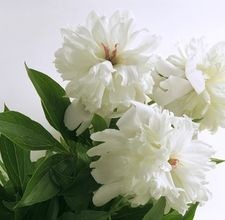Although peonies die back to the ground each fall in Minnesota’s climate, the roots stay alive beneath the soil. They flourish again each spring to produce showy pink, red, white or yellow flowers. Even when they’re not blooming, their glossy green leaves provide a background for other flowers in the garden. They can take a year or two to bloom after you first plant them, but once established, they may grow for years with minimal care.
- Difficulty:
- Easy
Instructions
Things You’ll Need
- 5-10-10 fertilizer
- Stake and twine or peony ring
- Pruning shears
- Mulch
- Plant peonies in either spring or fall, in a well-drained location that receives full sun. Space dwarf varieties 2 feet apart and standard varieties 4 feet apart. Place them so the tops are 1 1/2 to 2 inches below the soil, with the buds pointing upward. "A common error is to plant them too deep, which means they won’t bloom," according to Anne Hancheck of the University of Minnesota Extension.
- Water peonies during dry weather their first summer, but only in a noticeable drought after that. They tolerate dry soils well. The University of Minnesota Extension recommends watering in the middle of the day and at the base, to keep the leaves dry and discourage disease.
- Feed peonies with 5-10-10 or similar low-nitrogen fertilizer, when the stems have grown 2 to 3 inches in the spring. Water the fertilizer around the plants or spread dry fertilizer at least 12 inches from the plant stems and hoe it into the top 1 to 2 inches of the soil. Avoid getting it too near the stems or digging too deep and damaging the roots.
- Support peonies by tying them to stakes with twine or by pressing the legs of a wire peony ring into the ground around the growing plant.
- Pinch or cut off blooms after they’re done flowering. If stalks discolor and wilt or you see spots or brown buds with fungus spores after it rains, suspect Botrytis blight, one of the more common ailments of peonies in Minnesota. Prune off affected parts and destroy them away from the garden. Don’t compost them. Dip shears in a 10 percent bleach solution or spray 70 percent rubbing alcohol on the blades to disinfect them after working around diseased plants. "Fungicides are of limited effectiveness against this disease," according to the University of Minnesota Extension but copper sulfate sprayed on young shoots and the surrounding soil may help control it.
- Fertilize peonies again in early to mid summer, using the same process you used in the spring.
- Cut stalks to within 3 inches of the ground after frost has killed them. Destroy or compost them away from the plants to prevent spreading disease. Cover the plants with 2 to 3 inches of straw, leaves or other mulch. Remove the mulch in the spring when the plants begin to grow.
Tips & Warnings
-
Avoid transplanting or dividing peonies if possible. If you need to, dig them up in early spring or fall. Cut back the stems to 2 or 3 inches and gently cut the roots apart, leaving three to four eyes in each part. Dust cut areas with a fungicide and replant each section with the eyes up, 1 1/2 to 2 inches below the soil.


Deprecated: strpos(): Passing null to parameter #1 ($haystack) of type string is deprecated in /home/agriviek8Qv/agriviet.net/public_html/wp-includes/comment-template.php on line 2522